University Article Analysis Report: Gamified Learning in Education
VerifiedAdded on 2020/04/13
|6
|1396
|194
Report
AI Summary
This report provides an analysis of the article "Gamified learning: A role-playing approach to increase student in-class motivation" by Topiceanu (2017). The analysis covers the research topic, purpose, problems addressed, and the research question. The report summarizes the article and highlights the most interesting aspect: the positive impact of rewards on student performance and engagement. It further discusses how this aspect could be applied in a classroom setting to improve teaching experience and student motivation, suggesting strategies like providing material rewards, praise, and constructive feedback. The report references relevant literature to support the proposed actions, emphasizing the potential of gamification to enhance student satisfaction and promote collaborative learning. The study’s findings proved the positive influence of the proposal, and this was supported by the feedback of the participants at the end of each semester. The attitude of the learners towards grades and participation in the study was positive after taking part in the gamified system. Comparison of the control group with the study group highlighted that in the group for gamified, the participants were in favour of the modern approach.
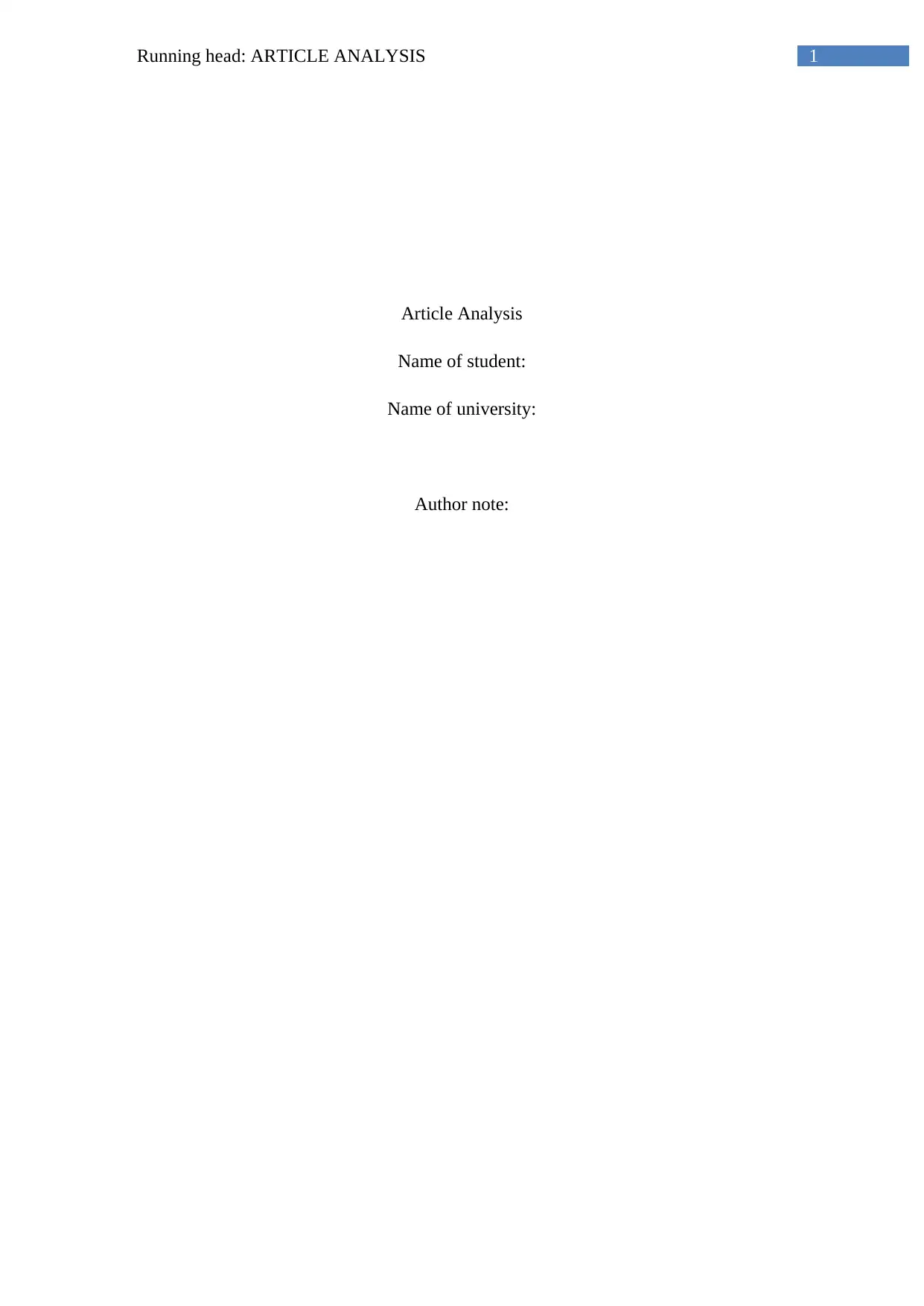
1Running head: ARTICLE ANALYSIS
Article Analysis
Name of student:
Name of university:
Author note:
Article Analysis
Name of student:
Name of university:
Author note:
Paraphrase This Document
Need a fresh take? Get an instant paraphrase of this document with our AI Paraphraser
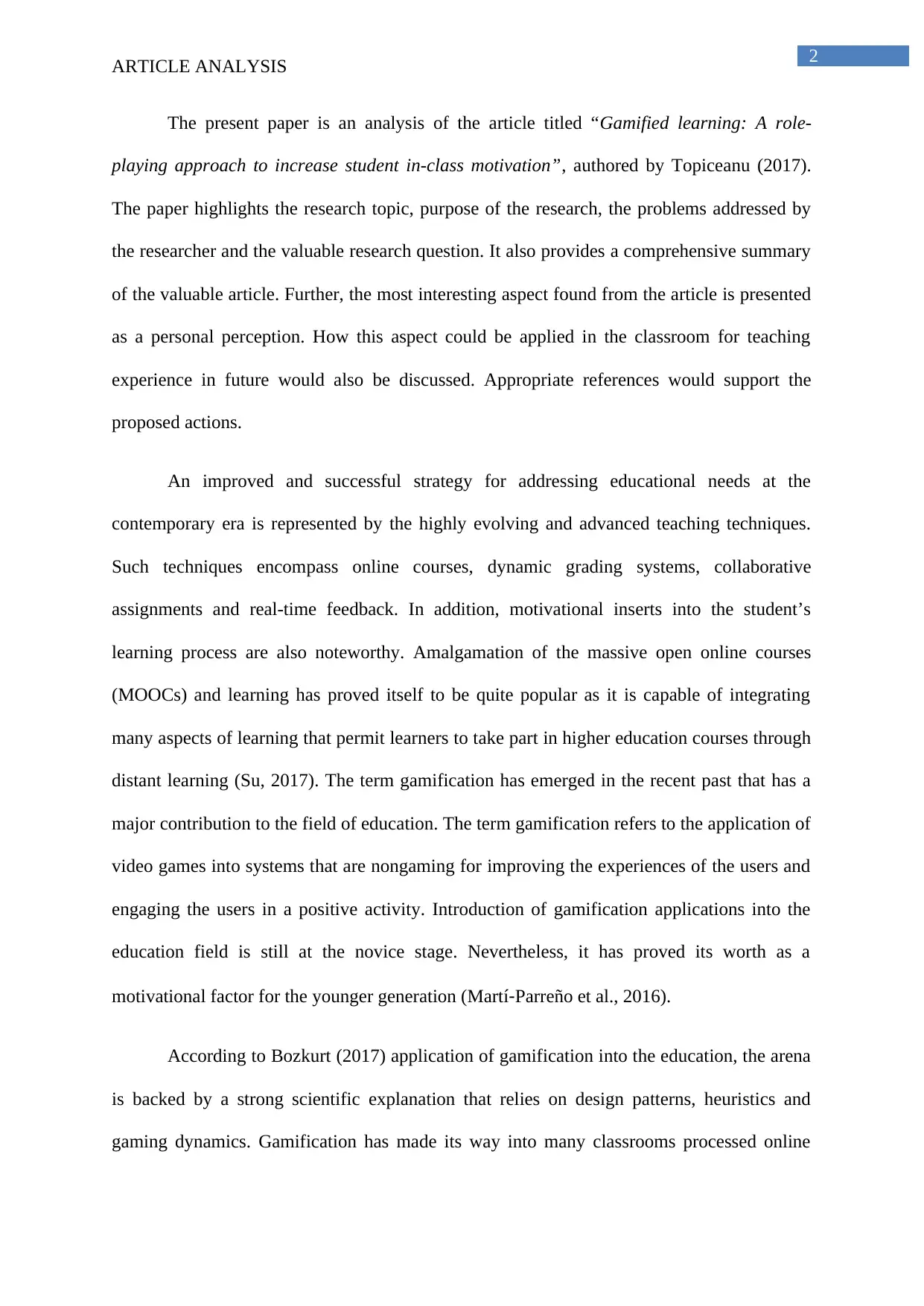
2
ARTICLE ANALYSIS
The present paper is an analysis of the article titled “Gamified learning: A role-
playing approach to increase student in-class motivation”, authored by Topiceanu (2017).
The paper highlights the research topic, purpose of the research, the problems addressed by
the researcher and the valuable research question. It also provides a comprehensive summary
of the valuable article. Further, the most interesting aspect found from the article is presented
as a personal perception. How this aspect could be applied in the classroom for teaching
experience in future would also be discussed. Appropriate references would support the
proposed actions.
An improved and successful strategy for addressing educational needs at the
contemporary era is represented by the highly evolving and advanced teaching techniques.
Such techniques encompass online courses, dynamic grading systems, collaborative
assignments and real-time feedback. In addition, motivational inserts into the student’s
learning process are also noteworthy. Amalgamation of the massive open online courses
(MOOCs) and learning has proved itself to be quite popular as it is capable of integrating
many aspects of learning that permit learners to take part in higher education courses through
distant learning (Su, 2017). The term gamification has emerged in the recent past that has a
major contribution to the field of education. The term gamification refers to the application of
video games into systems that are nongaming for improving the experiences of the users and
engaging the users in a positive activity. Introduction of gamification applications into the
education field is still at the novice stage. Nevertheless, it has proved its worth as a
motivational factor for the younger generation (Martí‐Parreño et al., 2016).
According to Bozkurt (2017) application of gamification into the education, the arena
is backed by a strong scientific explanation that relies on design patterns, heuristics and
gaming dynamics. Gamification has made its way into many classrooms processed online
ARTICLE ANALYSIS
The present paper is an analysis of the article titled “Gamified learning: A role-
playing approach to increase student in-class motivation”, authored by Topiceanu (2017).
The paper highlights the research topic, purpose of the research, the problems addressed by
the researcher and the valuable research question. It also provides a comprehensive summary
of the valuable article. Further, the most interesting aspect found from the article is presented
as a personal perception. How this aspect could be applied in the classroom for teaching
experience in future would also be discussed. Appropriate references would support the
proposed actions.
An improved and successful strategy for addressing educational needs at the
contemporary era is represented by the highly evolving and advanced teaching techniques.
Such techniques encompass online courses, dynamic grading systems, collaborative
assignments and real-time feedback. In addition, motivational inserts into the student’s
learning process are also noteworthy. Amalgamation of the massive open online courses
(MOOCs) and learning has proved itself to be quite popular as it is capable of integrating
many aspects of learning that permit learners to take part in higher education courses through
distant learning (Su, 2017). The term gamification has emerged in the recent past that has a
major contribution to the field of education. The term gamification refers to the application of
video games into systems that are nongaming for improving the experiences of the users and
engaging the users in a positive activity. Introduction of gamification applications into the
education field is still at the novice stage. Nevertheless, it has proved its worth as a
motivational factor for the younger generation (Martí‐Parreño et al., 2016).
According to Bozkurt (2017) application of gamification into the education, the arena
is backed by a strong scientific explanation that relies on design patterns, heuristics and
gaming dynamics. Gamification has made its way into many classrooms processed online
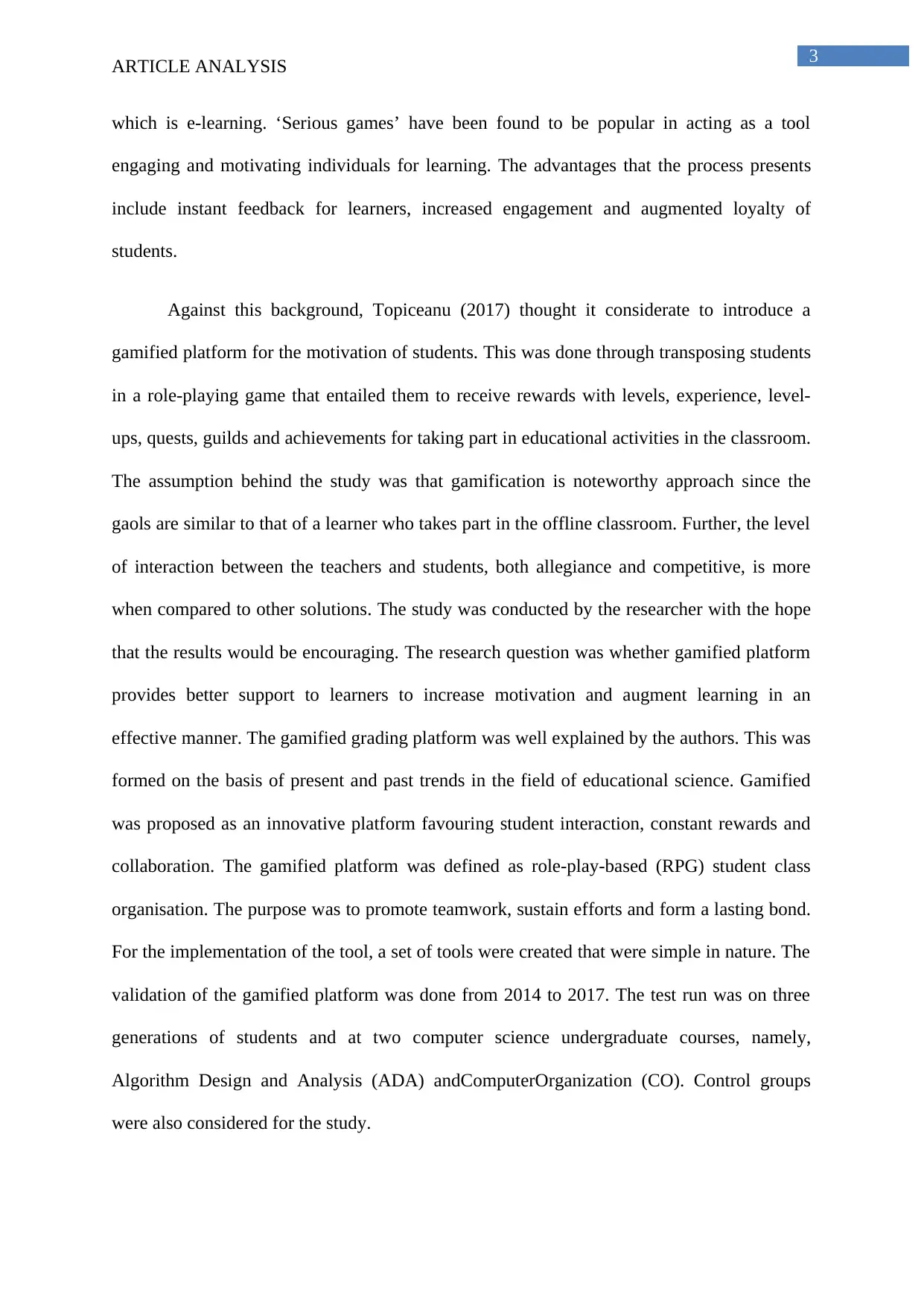
3
ARTICLE ANALYSIS
which is e-learning. ‘Serious games’ have been found to be popular in acting as a tool
engaging and motivating individuals for learning. The advantages that the process presents
include instant feedback for learners, increased engagement and augmented loyalty of
students.
Against this background, Topiceanu (2017) thought it considerate to introduce a
gamified platform for the motivation of students. This was done through transposing students
in a role-playing game that entailed them to receive rewards with levels, experience, level-
ups, quests, guilds and achievements for taking part in educational activities in the classroom.
The assumption behind the study was that gamification is noteworthy approach since the
gaols are similar to that of a learner who takes part in the offline classroom. Further, the level
of interaction between the teachers and students, both allegiance and competitive, is more
when compared to other solutions. The study was conducted by the researcher with the hope
that the results would be encouraging. The research question was whether gamified platform
provides better support to learners to increase motivation and augment learning in an
effective manner. The gamified grading platform was well explained by the authors. This was
formed on the basis of present and past trends in the field of educational science. Gamified
was proposed as an innovative platform favouring student interaction, constant rewards and
collaboration. The gamified platform was defined as role-play-based (RPG) student class
organisation. The purpose was to promote teamwork, sustain efforts and form a lasting bond.
For the implementation of the tool, a set of tools were created that were simple in nature. The
validation of the gamified platform was done from 2014 to 2017. The test run was on three
generations of students and at two computer science undergraduate courses, namely,
Algorithm Design and Analysis (ADA) andComputerOrganization (CO). Control groups
were also considered for the study.
ARTICLE ANALYSIS
which is e-learning. ‘Serious games’ have been found to be popular in acting as a tool
engaging and motivating individuals for learning. The advantages that the process presents
include instant feedback for learners, increased engagement and augmented loyalty of
students.
Against this background, Topiceanu (2017) thought it considerate to introduce a
gamified platform for the motivation of students. This was done through transposing students
in a role-playing game that entailed them to receive rewards with levels, experience, level-
ups, quests, guilds and achievements for taking part in educational activities in the classroom.
The assumption behind the study was that gamification is noteworthy approach since the
gaols are similar to that of a learner who takes part in the offline classroom. Further, the level
of interaction between the teachers and students, both allegiance and competitive, is more
when compared to other solutions. The study was conducted by the researcher with the hope
that the results would be encouraging. The research question was whether gamified platform
provides better support to learners to increase motivation and augment learning in an
effective manner. The gamified grading platform was well explained by the authors. This was
formed on the basis of present and past trends in the field of educational science. Gamified
was proposed as an innovative platform favouring student interaction, constant rewards and
collaboration. The gamified platform was defined as role-play-based (RPG) student class
organisation. The purpose was to promote teamwork, sustain efforts and form a lasting bond.
For the implementation of the tool, a set of tools were created that were simple in nature. The
validation of the gamified platform was done from 2014 to 2017. The test run was on three
generations of students and at two computer science undergraduate courses, namely,
Algorithm Design and Analysis (ADA) andComputerOrganization (CO). Control groups
were also considered for the study.
⊘ This is a preview!⊘
Do you want full access?
Subscribe today to unlock all pages.

Trusted by 1+ million students worldwide
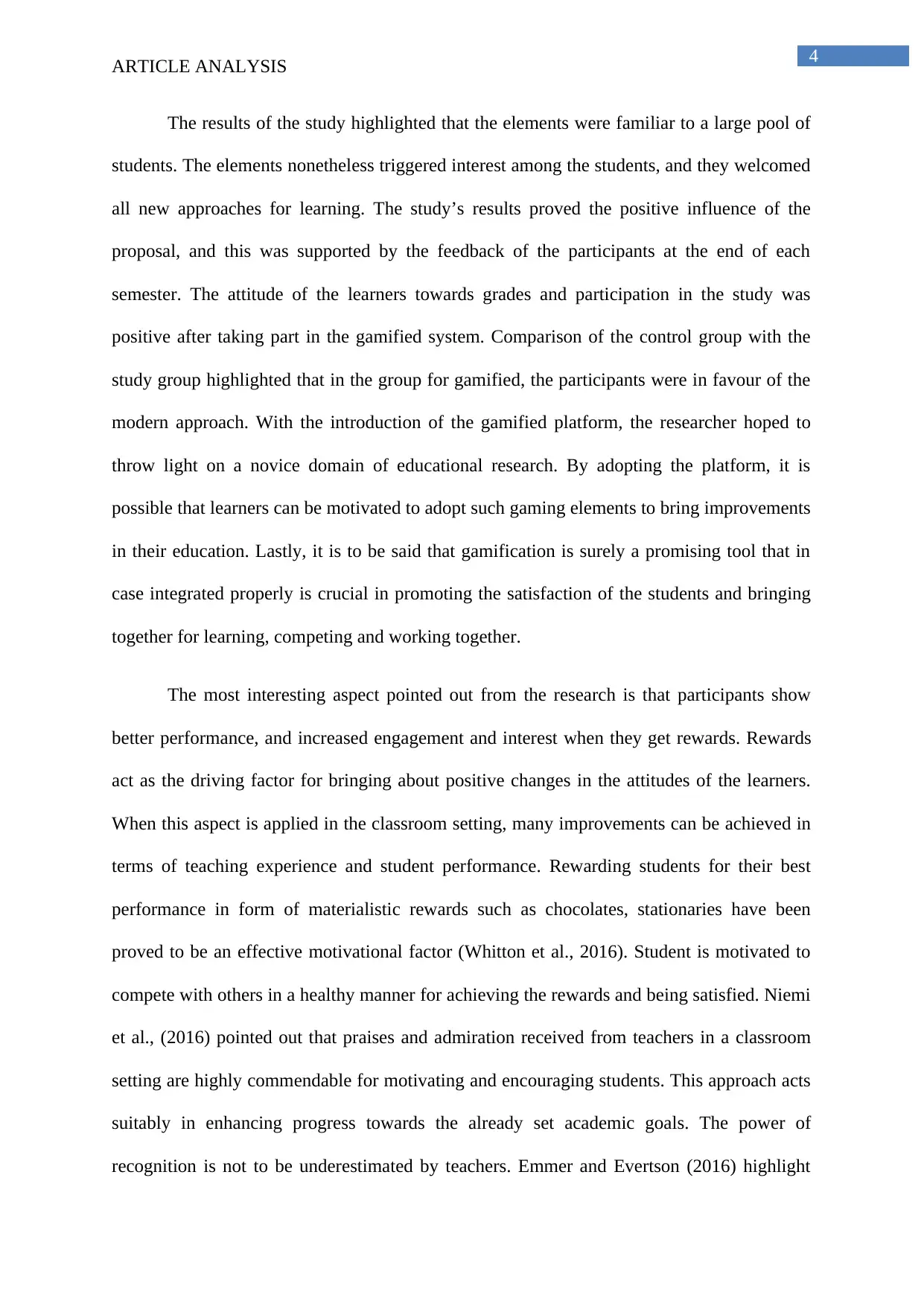
4
ARTICLE ANALYSIS
The results of the study highlighted that the elements were familiar to a large pool of
students. The elements nonetheless triggered interest among the students, and they welcomed
all new approaches for learning. The study’s results proved the positive influence of the
proposal, and this was supported by the feedback of the participants at the end of each
semester. The attitude of the learners towards grades and participation in the study was
positive after taking part in the gamified system. Comparison of the control group with the
study group highlighted that in the group for gamified, the participants were in favour of the
modern approach. With the introduction of the gamified platform, the researcher hoped to
throw light on a novice domain of educational research. By adopting the platform, it is
possible that learners can be motivated to adopt such gaming elements to bring improvements
in their education. Lastly, it is to be said that gamification is surely a promising tool that in
case integrated properly is crucial in promoting the satisfaction of the students and bringing
together for learning, competing and working together.
The most interesting aspect pointed out from the research is that participants show
better performance, and increased engagement and interest when they get rewards. Rewards
act as the driving factor for bringing about positive changes in the attitudes of the learners.
When this aspect is applied in the classroom setting, many improvements can be achieved in
terms of teaching experience and student performance. Rewarding students for their best
performance in form of materialistic rewards such as chocolates, stationaries have been
proved to be an effective motivational factor (Whitton et al., 2016). Student is motivated to
compete with others in a healthy manner for achieving the rewards and being satisfied. Niemi
et al., (2016) pointed out that praises and admiration received from teachers in a classroom
setting are highly commendable for motivating and encouraging students. This approach acts
suitably in enhancing progress towards the already set academic goals. The power of
recognition is not to be underestimated by teachers. Emmer and Evertson (2016) highlight
ARTICLE ANALYSIS
The results of the study highlighted that the elements were familiar to a large pool of
students. The elements nonetheless triggered interest among the students, and they welcomed
all new approaches for learning. The study’s results proved the positive influence of the
proposal, and this was supported by the feedback of the participants at the end of each
semester. The attitude of the learners towards grades and participation in the study was
positive after taking part in the gamified system. Comparison of the control group with the
study group highlighted that in the group for gamified, the participants were in favour of the
modern approach. With the introduction of the gamified platform, the researcher hoped to
throw light on a novice domain of educational research. By adopting the platform, it is
possible that learners can be motivated to adopt such gaming elements to bring improvements
in their education. Lastly, it is to be said that gamification is surely a promising tool that in
case integrated properly is crucial in promoting the satisfaction of the students and bringing
together for learning, competing and working together.
The most interesting aspect pointed out from the research is that participants show
better performance, and increased engagement and interest when they get rewards. Rewards
act as the driving factor for bringing about positive changes in the attitudes of the learners.
When this aspect is applied in the classroom setting, many improvements can be achieved in
terms of teaching experience and student performance. Rewarding students for their best
performance in form of materialistic rewards such as chocolates, stationaries have been
proved to be an effective motivational factor (Whitton et al., 2016). Student is motivated to
compete with others in a healthy manner for achieving the rewards and being satisfied. Niemi
et al., (2016) pointed out that praises and admiration received from teachers in a classroom
setting are highly commendable for motivating and encouraging students. This approach acts
suitably in enhancing progress towards the already set academic goals. The power of
recognition is not to be underestimated by teachers. Emmer and Evertson (2016) highlight
Paraphrase This Document
Need a fresh take? Get an instant paraphrase of this document with our AI Paraphraser

5
ARTICLE ANALYSIS
that providing constructive feedback is also a form of rewards that aims to enhance the
motivation of the students. Students feel encouraged when they receive constructive feedback
highlighting both positive and negative sides of their performances. Students under such
condition feel that their efforts have been recognised and that there are further chances of
improvements.
ARTICLE ANALYSIS
that providing constructive feedback is also a form of rewards that aims to enhance the
motivation of the students. Students feel encouraged when they receive constructive feedback
highlighting both positive and negative sides of their performances. Students under such
condition feel that their efforts have been recognised and that there are further chances of
improvements.
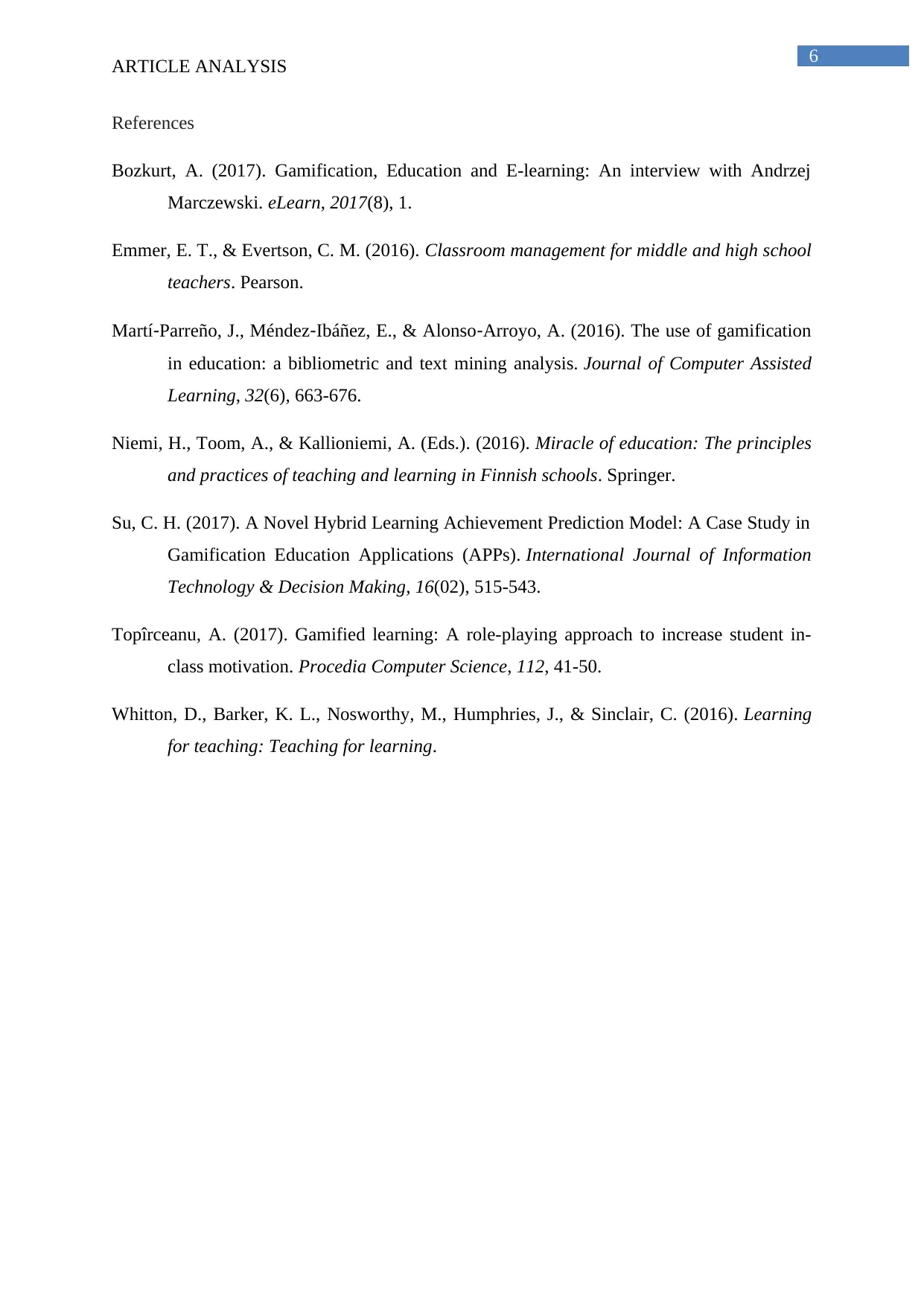
6
ARTICLE ANALYSIS
References
Bozkurt, A. (2017). Gamification, Education and E-learning: An interview with Andrzej
Marczewski. eLearn, 2017(8), 1.
Emmer, E. T., & Evertson, C. M. (2016). Classroom management for middle and high school
teachers. Pearson.
Martí‐Parreño, J., Méndez‐Ibáñez, E., & Alonso‐Arroyo, A. (2016). The use of gamification
in education: a bibliometric and text mining analysis. Journal of Computer Assisted
Learning, 32(6), 663-676.
Niemi, H., Toom, A., & Kallioniemi, A. (Eds.). (2016). Miracle of education: The principles
and practices of teaching and learning in Finnish schools. Springer.
Su, C. H. (2017). A Novel Hybrid Learning Achievement Prediction Model: A Case Study in
Gamification Education Applications (APPs). International Journal of Information
Technology & Decision Making, 16(02), 515-543.
Topîrceanu, A. (2017). Gamified learning: A role-playing approach to increase student in-
class motivation. Procedia Computer Science, 112, 41-50.
Whitton, D., Barker, K. L., Nosworthy, M., Humphries, J., & Sinclair, C. (2016). Learning
for teaching: Teaching for learning.
ARTICLE ANALYSIS
References
Bozkurt, A. (2017). Gamification, Education and E-learning: An interview with Andrzej
Marczewski. eLearn, 2017(8), 1.
Emmer, E. T., & Evertson, C. M. (2016). Classroom management for middle and high school
teachers. Pearson.
Martí‐Parreño, J., Méndez‐Ibáñez, E., & Alonso‐Arroyo, A. (2016). The use of gamification
in education: a bibliometric and text mining analysis. Journal of Computer Assisted
Learning, 32(6), 663-676.
Niemi, H., Toom, A., & Kallioniemi, A. (Eds.). (2016). Miracle of education: The principles
and practices of teaching and learning in Finnish schools. Springer.
Su, C. H. (2017). A Novel Hybrid Learning Achievement Prediction Model: A Case Study in
Gamification Education Applications (APPs). International Journal of Information
Technology & Decision Making, 16(02), 515-543.
Topîrceanu, A. (2017). Gamified learning: A role-playing approach to increase student in-
class motivation. Procedia Computer Science, 112, 41-50.
Whitton, D., Barker, K. L., Nosworthy, M., Humphries, J., & Sinclair, C. (2016). Learning
for teaching: Teaching for learning.
⊘ This is a preview!⊘
Do you want full access?
Subscribe today to unlock all pages.

Trusted by 1+ million students worldwide
1 out of 6
Related Documents
Your All-in-One AI-Powered Toolkit for Academic Success.
+13062052269
info@desklib.com
Available 24*7 on WhatsApp / Email
![[object Object]](/_next/static/media/star-bottom.7253800d.svg)
Unlock your academic potential
Copyright © 2020–2025 A2Z Services. All Rights Reserved. Developed and managed by ZUCOL.





